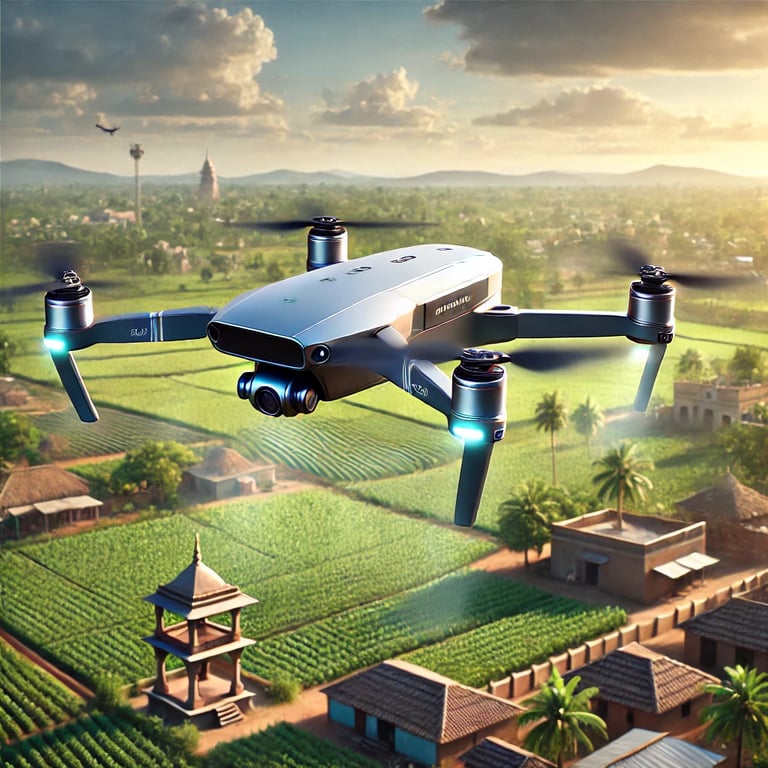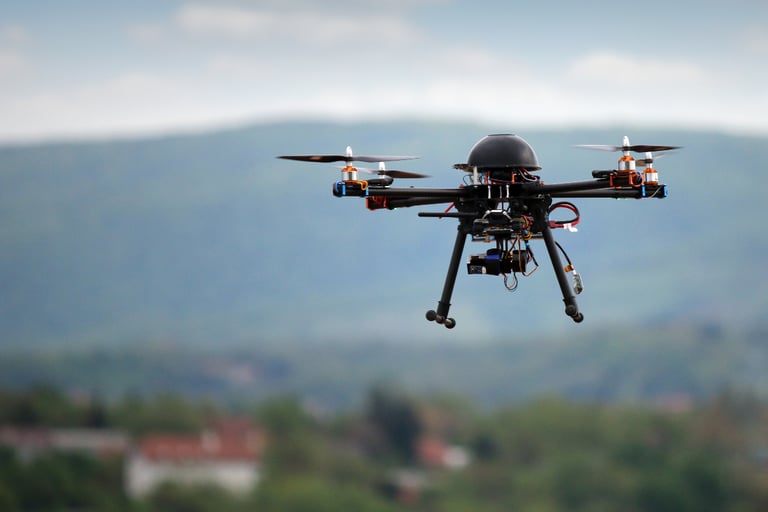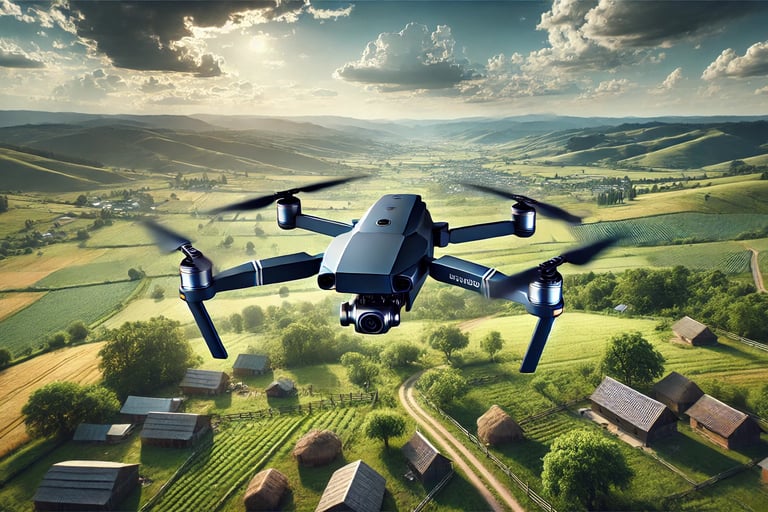The Year in Review: Developments in the Drone Industry in 2024 in India
Discover the transformative advancements in the drone industry in 2024, with a focus on India's rise as a global leader. From AI-driven drones to revolutionary applications in agriculture, logistics, healthcare, and defense, this blog explores key milestones, government policies like the PLI scheme, and future trends shaping the industry. The sky is just the beginning!
CURRENT TECHNOLOGIES


The global drone industry experienced unprecedented growth in 2024, and India played a significant role in shaping this narrative. With government initiatives, rising startups, and increasing adoption across industries, India emerged as one of the fastest-growing drone markets. This blog provides an overview of the drone industry in 2024 and highlights the key developments specific to India.
Key Global Developments in the Drone Industry
Before diving into India-specific advancements, let’s quickly recap the major global trends:
AI-Driven Autonomy: Drones became smarter, with AI enabling advanced navigation, obstacle avoidance, and decision-making.
Regulatory Progress: Implementation of Remote ID and approvals for Beyond Visual Line of Sight (BVLOS) operations facilitated new use cases.
Industry Expansion: Sectors like logistics, agriculture, energy, and public safety embraced drones for increased efficiency and cost savings.
Now, let’s focus on India’s contributions and progress in the drone sector.
Major Drone Developments in India
Government Support and Policies
India made significant strides in 2024 with forward-looking policies aimed at fostering drone innovation:
Drone Rules, 2021 – Full Implementation: The progressive Drone Rules introduced earlier continued to drive the industry in 2024. Key aspects like simplified permissions, exemptions for nano drones, and reduced fees encouraged startups and enterprises to adopt drone technology.
Production-Linked Incentive (PLI) Scheme: The Indian government extended its PLI scheme for drones and drone components, allocating over ₹120 crore to support manufacturers. This led to increased local production and reduced dependence on imports.
Digitization of Approvals: The government launched the Digital Sky Platform 2.0, streamlining the approval process for drone operations. Features like automated No-Permission-No-Takeoff (NPNT) systems simplified compliance for businesses.
Focus on 'Make in India': The government encouraged domestic manufacturing of drones and components, aligning with the Atmanirbhar Bharat (Self-Reliant India) initiative. This boosted local production and exports.
Industry Applications in India
Agriculture
Subsidies for Agri-Drones: The Ministry of Agriculture continued subsidizing drones for small farmers, enabling them to access affordable drone solutions.
Spraying and Monitoring: Startups like Garuda Aerospace and IoTechWorld developed drones for pesticide spraying and crop health monitoring. This reduced manual labor costs by up to 50%.
FPO Integration: Farmer Producer Organizations (FPOs) adopted drones to monitor fields collectively, increasing yield and profitability.
Logistics and Delivery
Drone Delivery Trials: India witnessed extensive trials of drone deliveries in 2024:
Swiggy and Zomato piloted food deliveries in cities like Bangalore and Hyderabad.
Zipline, in collaboration with the Telangana government, expanded medical drone deliveries, particularly to rural areas, cutting delivery times from hours to minutes.
India Post Trials: India Post began testing drone deliveries in remote areas of the Northeast, aiming to revolutionize mail delivery.
Healthcare
Telemedicine and Medical Supplies:
Drones played a critical role in supplying vaccines and emergency medicines to hard-to-reach areas in states like Assam and Uttarakhand.
The 'Medicine from the Sky' initiative, supported by the World Economic Forum, expanded across multiple states, including Maharashtra and Karnataka.
Infrastructure and Inspections
Urban Development: Drones mapped urban projects under Smart City initiatives, ensuring accurate planning and faster execution.
Energy Inspections: Companies like Tata Power and NTPC deployed drones for inspections of solar farms, power lines, and wind turbines, reducing inspection costs by 30%.
Environmental Conservation
Reforestation Projects: Drones planted saplings in degraded forest areas of Madhya Pradesh and Odisha, accelerating reforestation efforts.
Wildlife Monitoring: The Forest Department in Karnataka used drones to monitor tiger populations and prevent poaching in national parks.
River Cleaning: Drones with water-quality sensors were deployed along the Ganga River to monitor pollution levels under the Namami Gange Program.
Public Safety
Traffic and Crowd Control: Police forces in Delhi, Mumbai, and Chennai employed drones for crowd management during major events and festivals.
Disaster Response:
During floods in Assam, drones conducted aerial surveys to identify stranded populations and deliver relief supplies.
In coastal areas of Tamil Nadu and Andhra Pradesh, drones were used to assess cyclone damage and coordinate rescue efforts.
Defense and Security
Indigenous Defense Drones:
India’s DRDO (Defence Research and Development Organization) developed advanced drones for military reconnaissance and surveillance.
Companies like IdeaForge supplied tactical drones to the Indian Army.
Counter-Drone Systems: With increasing security threats, the Indian Armed Forces procured anti-drone systems to protect sensitive areas like borders and airbases.
India’s Thriving Drone Startup Ecosystem
India’s startup ecosystem flourished in 2024, with several players contributing innovative solutions:
Garuda Aerospace: Focused on agricultural drones, the company secured multiple government contracts.
Asteria Aerospace: Specialized in surveillance drones for defense and industrial applications.
Skye Air Mobility: Led the charge in drone-based delivery solutions, particularly in healthcare logistics.
Thanos Technologies: Pioneered hydrogen-powered drones for eco-friendly operations.
Funding and Investment
India’s drone startups collectively raised over ₹1,000 crore in funding in 2024. Prominent investors included Sequoia Capital, Accel, and Startup India Seed Fund Scheme.
Collaboration with global giants like Qualcomm and Intel accelerated research in AI and sensor technology.
Challenges in India
Despite the progress, India faced hurdles in expanding its drone ecosystem:
Regulatory Delays: While policies were progressive, delays in state-level implementation slowed adoption in some regions.
Infrastructure Gaps: Lack of drone ports, charging stations, and training facilities hindered large-scale deployments.
Cybersecurity Risks: Cases of drone hacking emphasized the need for robust cybersecurity frameworks.
Looking Ahead: 2025 and Beyond
India’s drone industry is poised for further growth. Key focus areas include:
Urban Air Mobility: Pilot programs for passenger drones and air taxis in cities like Mumbai and Bangalore.
Skill Development: Training programs to produce certified drone pilots, supported by government initiatives like Skill India.
Eco-Friendly Innovations: Development of solar-powered and hydrogen-powered drones to reduce the environmental footprint.
Conclusion
India’s drone industry in 2024 demonstrated the country’s potential as a global leader in drone technology. With government support, thriving startups, and growing adoption across industries, drones are transforming India’s agriculture, healthcare, logistics, and more. The developments of 2024 have laid a strong foundation for 2025 and beyond, where drones will play a pivotal role in driving innovation and solving real-world challenges.




